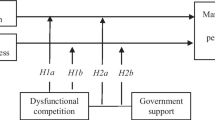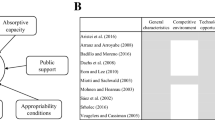Abstract
The Taiwanese government has started to promote the concept of the “servitization of manufacturing” with a view to accelerating the servitization of the country’s manufacturing industries. The objective is to enable Taiwan’s industries to progress from manufacturing toward innovation, R&D, and services. The main purpose of this study is to explore the factors determining the formation of R&D consortia among Taiwanese firms. In a literature review and analysis, we distinguish the factors underlying the formation of these R&D consortia into internal and external factors. The findings show that four external factors are positively significant: the degree of industry competition, the appropriability conditions of innovations, government subsidies, and cooperation between firms in different industries. Firm size and firm age are among the internal factors that are significantly positive in the formation of R&D consortia.
Similar content being viewed by others
References
Allison PD (1984) Event history analysis: regression for longitudinal event data. SAGE, Beverly Hills
Anand BN, Khanna T (2000) Do firms learn to create value? The case of alliances. Strateg Manag J 21(3):295–316
Baum JAC, Oliver C (1991) Institutional linkages and organizational mortality. Adm Sci Q 36(2):2187–2218
Baum JAC, Calabrese T, Silverman BS (2000) Don’t go it alone: alliance network composition and startups’ performance in Canadian biotechnology. Strateg Manag J 21(3):267–294
Branstetter L, Sakakibara M (2002) When do research consortia work well and why? Evidence from Japanese panel data. Am Econ Rev 92(1):143–159
Chen H, Chen TJ (2002) Asymmetric strategic alliance: a network view. J Bus Res 55(12):1007–1013
Cohen WM, Nelson RR, Walsh JP (2000) Protecting their intellectual assets: appropriability conditions and why U.S. manufacturing firms patent (or Not). Working Paper, National Bureau of Economic Research
Cohen WM, Goto A, Nagata A, Nelson RR, Walsh JP (2002) R&D spillovers, patents and the incentives to innovate in Japan and the United States. Res Policy 31(8–9):1349–1367
Cox DR (1972) Regression models and life-tables. J Roy Stat Soc B 34(2):187–220
Eisenhardt KM, Schoonhoven CB (1996) Resource-based view of strategic alliance formation: strategic and social effects in entrepreneurial firms. Organ Sci 7(2):136–150
Fukugawa N (2006) Determining factors in innovation of small firm networks: a case of cross industry groups in Japan. Small Bus Econ 27(2–3):181–193
Hagedoorn J (1996) Trends and patterns in strategic technology partnering since the early seventies. Rev Ind Organ 11(5):601–616
Hamel G (1991) Competition for competence and interpartner learning within international strategic alliances. Strateg Manag J 12(1):83–105
Hsu CW, Chiang HC (2001) The government strategy for the upgrading of industrial technology in Taiwan. Technovation 21(2):123–132
Hsu FM, Hsueh CC (2009) Measuring relative efficiency of government-sponsored R&D projects: a three-stage approach. Eval Program Plann 32(2):178–186
Hu MW, Chi S (1998) The changing competitiveness of Taiwan’s manufacturing SMEs. Small Bus Econ 11(4):315–326
Huarng CC, Chu PY, Chiang YU (2008) A fuzzy AHP application in government-sponsored R&D project selection. Omega 36(6):1038–1052
Jan TS, Chen Y (2006) The R&D system for industrial development in Taiwan. Technol Forecast Soc Chang 73(5):559–574
Kale P, Dyer JH, Singh H (2002) Alliance capability, stock market response, and long-term alliance success: the role of the alliance function. Strateg Manag J 23(8):747–767
Kennedy A, Keeney K (2009) Strategic partnerships and the internationalisation process of software SMEs. Serv Bus 3(3):259–273
Kogut B, Shan W, Walker G (1992) The make-or-cooperate decision in the context of an industry network. In: Norhria N, Eccls R (eds) Networks and organizations: structure, form, and action. Harvard Business School Press, Boston, MA, pp 348–365
Levitt B, March JG (1988) Organizational learning. Annu Rev Sociol 14(3):319–340
Lin FJ (2010) The determinants of foreign direct investment in China: the case of Taiwanese firms in the IT industry. J Bus Res 63(5):479–485
López-Sánchez JI, Arroyo-Barrigüete JL, Ribeiro D (2008) Development of a technological competition model in the presence of network effects from the modified law of Metcalfe. Serv Bus 2(2):83–98
Lyles MA (1988) Learning among joint venture sophisticated firms. Manage Int Rev 28(4):85–98
Mathews JA (2002) The origins and dynamics of Taiwan’s R&D consortia. Res Policy 31(4):633–651
Miotti L, Sachwald F (2003) Co-operative R&D: why and with whom? An integrated framework of analysis. Res Policy 32(8):1481–1499
Mitchell W, Singh K (1992) Incumbents’ use of pre-entry alliances before expansion into new technical subfields of an industry. J Econ Behav Organ 18(3):347–372
Okamuro H (2007) Determinants of successful R&D cooperation in Japanese small businesses: the impact of organizational and contractual characteristics. Res Policy 36(10):1529–1544
Reed R, Storrud-Barnes SF (2009) Systematic performance differences across the manufacturing-service continuum. Serv Bus 3(4):319–339
Sakakibara M (2002) Formation of R&D consortia: industry and company effects. Strateg Manag J 23(11):1033–1050
Shan W (1990) An empirical analysis of organizational strategies by entrepreneurial high-technology firms. Strateg Manag J 11(2):129–139
Sher PJ, Yang PY (2005) The effects of innovative capabilities and R&D clustering on firm performance: the evidence of Taiwan’s semiconductor industry. Technovation 25(1):33–43
Simonin BL (1997) The importance of collaborative know-how: an empirical test of the learning organization. Acad Manag J 40(5):1150–1174
Singh K (1997) The impact of technological complexity and interfirm cooperation on business survival. Acad Manag J 40(2):339–367
Spence M (1984) Cost reduction, competition, and industry performance. Econometrica 52(1):101–121
Tuma NB, Hannan MT (1984) Social dynamics: models and methods. Academic Press, Orlando
Un AC, Romero-Martínez AM, Montoro-Sánchez A (2009) Determinants of R&D collaboration of service firms. Serv Bus 3(4):373–394
Author information
Authors and Affiliations
Corresponding author
Rights and permissions
About this article
Cite this article
Lin, FJ., Lin, YH. The determinants of successful R&D consortia: government strategy for the servitization of manufacturing. Serv Bus 6, 489–502 (2012). https://doi.org/10.1007/s11628-012-0157-7
Received:
Accepted:
Published:
Issue Date:
DOI: https://doi.org/10.1007/s11628-012-0157-7




